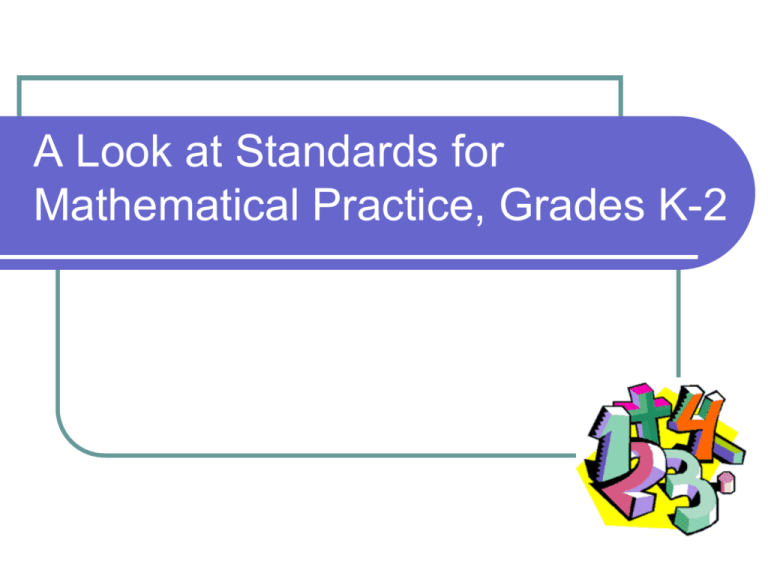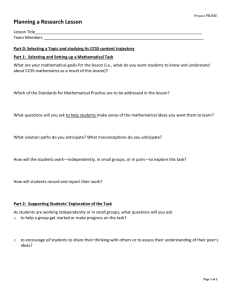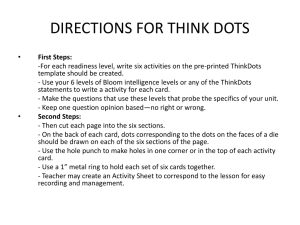CCSS 101: Standards for Math Practices
advertisement

A Look at Standards for Mathematical Practice, Grades K-2 Learning Intentions We Are Learning To: Recognize how Mathematical Practices 1, 2 and 5—sense making, reasoning, and tools—are connected to a selected standards’ content progression for learning basic facts. Identify how students will develop and demonstrate Practices 1, 2 and 5 in their work and discussions. Success Criteria We will know we are successful when we can articulate how Mathematical Practice Standards 1, 2 and 5—sense making, reasoning, and tools—are infused in mathematical tasks or lessons for a standards’ content progression. Wisconsin Common Core Standards Getting started… Mentally compute the answer to the following… No pencil 1005 – 998 54 + 48 or paper please! Turn and share your strategy. Why does your strategy work? What do you understand about number relationships that allow you to mentally compute answers? How does this understanding grow in young children? Wisconsin CCSS Standards for Mathematical Practice 8 Practices Describe ways in which students ought to engage with mathematics. Mathematical 21-26 Content Standards Content Standards per grade, K-2 Describe what students should understand and be able to do Guidance from CCSS Review the Key Standards for Mathematical Practices for our work today. What sounds familiar as you glance through these practices? Mathematical Practices The Mathematical Practices rest on “important ‘processes and proficiencies’ with longstanding importance in mathematics education” (CCSS, 2010, p. 6). National Council of Teachers of Mathematics (NCTM, 2000) Process Standards National Research Council (NRC, 2001) Strands of Mathematical Proficiency (Adding It Up) Domain Content strand across grades: Operations & Algebraic Thinking Cluster “Big Idea” that groups together a set of related standards. Standards Statements that define what students should understand and be able to do at a grade level. A Content Standards Progression Domain: Operations and Algebraic Thinking (OA) Clusters: K: Understand addition as putting together and adding to, and understand subtraction as taking apart and taking from. 1: Understand and apply properties of operations and the relationship between addition and subtraction. 1&2: Add and subtract within 20. Standards: K.OA.3; K.OA.4; 1.OA.4; 1.OA.6; 2.OA.2 Let’s start with the end in mind… Standard 2.OA.2: Fluently add and subtract within 20 using mental strategies. By end of Grade 2, know from memory all sums of two one-digit numbers. “Acquiring proficiency in single-digit arithmetic involves much more than memorizing.” (Adding It Up, NRC, 2001, p. 6) What is that “more” and how do we help students get there? Laying the Foundation in PK-K K.OA.3 Decompose numbers less than or equal to 10 into pairs in more than one way, e.g., by using objects or drawings and record each decomposition by a drawing or equation (e.g., 5 = 2 + 3 and 5 = 4 + 1). K.OA.4 For any number from 1 to 9, find the number that makes 10 when added to the given number, e.g., by using objects or drawings, and record the answer with a drawing or equation. Prompting quantitative reasoning a.k.a “number relationships” Dot Patterns & Ten Frames Play “Flash” How many dots did you see? How did you see it? What’s the math? Dot Pattern How many dots? How did you see it? How many dots? How did you see it? How many dots? How did you see it? Ten Frames Ten frames show relationships of small numbers to five and ten. How many dots? How did you see it? How many dots? How did you see it? How many dots? How did you see it? Laying a foundation for understanding Morgan, Dot Plates, & Ten Frames Enjoy! Through the lens of the Math Content K.OA.3: Decompose numbers less than or equal to 10 into pairs in more than one way, e.g., by using objects or drawings… K.OA.4: For any number from 1 to 9, find the number that makes 10 when added to the given number, e.g., by using objects or drawings... What is Morgan understanding and what is she able to do? Through the lens of the Math Practices Make sense of problems and persevere in solving them. Reason abstractly and quantitatively. Use appropriate tools strategically. How is Morgan engaged in these practices while working with the content of decomposing numbers? Guidance from CCSS Review the Grade 1 and Grade 2 Key Standards for Mathematical Content in regards to our work today. Small Group Discussion: What’s familiar? What’s new? How much emphasis is given to “mental strategies” in your curricula and classroom? Grade 1: Content Standard 1.OA.6 Add and subtract within 20, demonstrating fluency for addition and subtraction within 10. Use strategies such as counting on; making ten (e.g., 8 + 6 = 8 + 2 + 4 = 10 + 4 = 14); decomposing a number leading to a ten (e.g., 13 4 = 13 - 3 - 1 = 10 - 1 = 9); using the relationship between addition and subtraction (e.g., knowing that 8 + 4 = 12, one knows 12 - 8 = 4); and creating equivalent but easier or known sums (e.g., adding 6 + 7 by creating the known equivalent 6 + 6 + 1 = 12 + 1 = 13). Strategies for Single Digit Addition Make Use a ten. an easier “equivalent” problem. Use doubles Use fives Use a helping fact 8+6 Put 8 counters on your first frame & 6 counters on your second frame. Strategies: Make a ten. Use a double. Use fives. Use some other equivalent problem. Make a ten: 8 + 6 How could you make a ten? Make a ten: 8 + 6 How could you make a ten? Move 2 counters to the top frame. Then you have 10 and 4 more counters. Write an equation. 8 + 6 = 8 + 2 + 4 = 10 + 4 = 14 Use a double: 8 + 6 What doubles might you use? Reason 6 + 6 = 1 12. Then add 2 more. Write an equation. 8+6=6+6+2= 12 + 2 = 14 Use fives: 8 + 6 Can you see some fives? Where? Reason: 5 + 5 is 10; need to add 3 more and 1 more. Write an equation. 8+6=5+5+3+1 = 10 + 4 = 14 7+9 6+7 Select a problem. Draw a strategy card for the group. Everyone uses ten frames and counters to reason through the strategy and writes an equation(s) that shows the reasoning. Share, compare, and discuss as a group. Repeat with another strategy card. Reflect: Which strategies seem to work best for each problem? Decompose to ten: 15 – 6 Place 15 counters on the double ten frame. Completely fill one frame, place 5 on the other frame. Decompose to ten: 15 – 6 How can you remove 6 counters in parts by decomposing it in a way that gets you to or “leads to a ten”? Remove 5 counters to get to ten. Remove 1 more. Write an equation. 15 – 5 – 1 = 9 or 15 – 5 = 10; 10 – 1 = 9 Try it: 13 – 5 16 – 7 Use ten frames and counters to reason through the “Decompose to Ten” strategy. Write an equation(s) to show the reasoning. Share and discuss in your small group. --------------------------- Brainstorm: What other subtraction facts would lend themselves well to this strategy? Make a list of facts and try them out. Reflect How do these tasks engage you in the content learning infused with practices? (Mathematical Practices Standards 1, 2, 5) How do these tasks help you to better understand the mathematics? (Content Standards K.OA.4, K.OA.5, 1.OA.6) Checking in… Standard 2.OA.2: Fluently add and subtract within 20 using mental strategies. By end of Grade 2, know from memory all sums of two one-digit numbers. “Acquiring proficiency in single-digit arithmetic involves much more than memorizing.” (Adding It Up, NRC, 2001, p. 6) What is that “more” and how do we help students get there? What other practices were infused in the content learning? Provide specific examples. Summary We were learning to recognize three of the Standards for Mathematical Practices—sense making, reasoning, and tools— within a chosen Content Standards progression. We will know we are successful when we can articulate how both a Content Standard and a Standard for Mathematical Practice are infused in a math lesson in the classroom.








